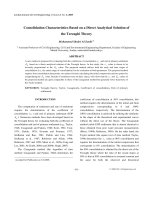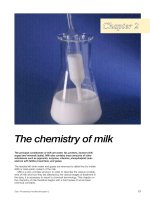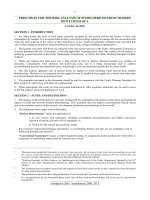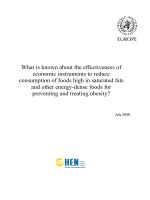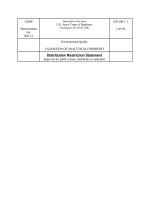Analytical chemistry of foods
Bạn đang xem bản rút gọn của tài liệu. Xem và tải ngay bản đầy đủ của tài liệu tại đây (3.97 MB, 180 trang )
Analytical Chemistry of Foods
Analytical Chemistry
of Foods
c. s.
JAMES
Seale-Hayne Faculty of Agriculture, Food and Land Use
Department of Agriculture and Food Studies
University of Plymouth
SPRINGER-SCIENCE+BUSINESS MEDIA,
B.v.
First edition 1995
© 1995 Springer Science+Business Media Dordrecht
Origina\ly published by Chapman & HalI in 1995
Typeset in 10112pt Times by Iulia Stevenson of Hove
ISBN 978-1-4613-5905-0
ISBN 978-1-4615-2165-5 (eBook)
DOI 10.1007/978-1-4615-2165-5
Apart from any fair dealing for the purposes of research or private study, or
criticism or review, as permitted under the UK Copyright Designs and Patents
Act, 1988, this publication may not be reproduced, stored; or transmitted, in any
form or by any means, without the prior permission in writing ofthe publishers,
or in the case of reprographic reproduction only in accordance with the terms of
the licences issued by the Copyright Licensing Agency in the UK, or in
accordance with the terms of licences issued by the appropriate Reproduction
Rights Organization outside the UK. Enquiries conceming reproduction outside
the terms stated here should be sent to the publishers at the Glasgow address
printed on this page.
The publisher makes no representation, express or implied, with regard to the
accuracy of the information contained in this book and cannot accept any legal
responsibility or Iiability for any errors or omissions that may be made.
A catalogue record for this book is available from the British Library
§
Printed on acid-free text paper, manufactured in accordance with ANSIINISO
Z39,48-1992 (permanence ofPaper)
Preface
Food laws were fIrst introduced in 1860 when an Act for Preventing the Adulteration
of Articles of Food or Drink was passed in the UK. This was followed by the Sale
of Food Act in 1875, also in the UK, and later, in the USA, by the Food and Drugs
Act of 1906. These early laws were basically designed to protect consumers against
unscrupulous adulteration of foods and to safeguard consumers against the use of
chemical preservatives potentially harmful to health. Subsequent laws, introduced
over the course of the ensuing century by various countries and organisations,
have encompassed the features of the early laws but have been far wider reaching
to include legislation relating to, for example, specifIc food products, specifIc
ingredients and specifIc uses.
Conforming to the requirements set out in many of these laws and guidelines
requires the chemical and physical analysis of foods. This may involve qualitative
analysis in the detection of illegal food components such as certain colourings or,
more commonly, the quantitative estimation of both major and minor food
constituents. This quantitative analysis of foods plays an important role not only
in obtaining the required information for the purposes of nutritional labelling but
also in ensuring that foods conform to desired flavour and texture quality attributes.
This book outlines the range oftechniques available to the food analyst and the
theories underlying the more commonly used analytical methods in food studies.
Details of specifIc procedures for undertaking the routine analysis of the major
food constituents are provided and, where appropriate, reference is made to offIcial
methods. The latter should be referred to in the case of disputes and legislative
requirements in order that full details regarding apparatus design, product
specifIcations and technical procedures may be obtained.
C.SJ.
Contents
Abbreviations
xi
Part 1 Theory
1
1
2
Introduction
3
Assessment of analytical methods and data
5
2.1
2.2
2.3
5
6
2.4
3
7
7
8
9
10
11
Principles of techniques used in food analysis
13
3.1
13
13
16
16
16
17
18
18
26
3.2
4
Requirements and choice of analytical methods
Presentation of data
Quality of data
2.3.1 Procedures to improve quality of data
Statistical assessment of quality of data
2.4.1 Precision
2.4.2 Reproducibility
2.4.3 Accuracy
Classical methods
3.1.1 Titrimetric analysis
3.1.2 Gravimetric procedures
3.1.3 Solvent extraction methods
3.1.4 Refractometry
3.1.5 Polarimetry
Instrumental and modem methods
3.2.1 Spectroscopic methods
3.2.2 Chromatography
3.2.3 Electrophoresis
3.2.4 Immunochemical methods
Theory of analytical methods for specific food constituents
4.1
4.2
4.3
4.4
4.5
Sampling
Moisture and water activity
4.2.1 Methods of measuring moisture
Protein
4.3.1 Kjeldahl method
4.3.2 Direct distillation methods
4.3.3 Thermal combustion methods
4.3.4 Dye binding methods
4.3.5 Formol titration
4.3.6 Spectroscopic methods
Fats
4.4.1 Gravimetric solvent extraction procedures
4.4.2 Volumetric methods
4.4.3 Instrumental methods
4.4.4 Study of the nature offats and oils
Carbohydrates
4.5.1 Determination of available carbohydrates
4.5.2 Estimation of dietary fibre in foods
30
31
37
37
37
38
40
41
43
43
44
45
45
46
46
50
51
51
53
56
59
VIII
ANALYTICAL CHEMISTRY OF FOODS
4.6
4.7
4.8
Micronutrients
4.6.1 Mineral elements and ash
4.6.2 Vitamins
Food energy
Additives
62
62
63
64
66
Part 2 Experimental
69
5
Experimental procedures - estimation of major food constituents
71
5.1
5.2
5.3
5.4
5.5
71
72
73
75
5.6
5.7
5.8
5.9
5.10
5.11
5.12
5.13
5.14
5.15
5.16
5.17
5.18
5.19
5.20
5.21
5.22
5.23
5.24
5.25
5.26
5.27
5.28
5.29
5.30
6
Laboratory safety
Sampling
Determination of moisture and total solids
Determination of ash content
Determination of mineral elements in foods by atomic absorption
spectrophotometry (ashing process)
Determination of mineral elements in canned food products by atomic
absorption spectrophotometry (non-ashing process)
Determination of calcium in foods by permanganate titration
Determination of phosphorus by the vanadate colorimetric method
Determination of phosphorus by the molybdenum blue colorimetric method
Determination of iron by the bipyridyl colorimetric method
Determination of nitrogen and protein by the Kjeldahl method using the
Kjeltec instrument
Determination of protein content by the formol titration
Determination of fat by the Soxhlet and Soxtec methods
Determination of the fat content of dairy products by the Gerber method
Determination of fat by the Mojonnier method
Determination offat by the Rose-Gottlieb method
Determination of fat by the Werner-Schmid method
Determination of the fat content of cheese by the modified SBR
(Schmid-Bondzynski-Ratzlaft) method
Determination of fat by the Weibull-BerntroplWeibull-Stoldt method
Determination of dietary fibre in foods by the neutral detergent fibre method
Determination of dietary fibre by the Englyst enzymatic instrumental method
Determination of dietary fibre in foods by the AOAC enzymatic gravimetric
method
Volumetric determination of sugars by copper reduction (Lane and Eynon
method)
Volumetric determination of sugars by copper reduction (Lane and Eynon
method - constant volume modification)
DNS colorimetric determination of available carbohydrates in foods
Determination oflactose in milk by the Chloramine-T method
Determination of the lactose content of milk by polarimetry
Determination oflactose in cheese by the phenol colorimetric method
Identification and determination of sugars in milk products by HPLC
Calculation of the calorific value of foods
General food studies
6.1
6.2
6.3
6.4
6.5
6.6
6.7
6.8
Determination of ascorbic acid by titration
Gas chromatographic study of the fatty acid composition offats
Determination of the iodine value of fats and oils
Determination of the saponification value offats
Determination of sulphur dioxide by iodine titration
Determination of total sulphur dioxide (free and combined) using distillation
methods
Determination of the salt content of dairy products (Volhard method)
Determination of the salt content of brine (Mohr titration)
76
78
80
82
84
86
88
90
91
93
96
98
100
102
104
106
108
114
117
120
124
126
128
13 0
132
135
137
137
140
142
144
146
148
150
152
CONTENTS
6.9
6.10
6.11
6.12
6.13
6.14
6.15
6.16
6.17
6.18
7
Titrimetric determination ofthe chloride content of meat products
Colorimetric determination of nitrates and nitrites in meat products and brine
Spectrophotometric determination of antioxidants
Extraction and colorimetric estimation of gallates
Determination of alcohol in beverages by gas chromatography
Determination of alcohol by the distillation method
Titratable acidity of fruit juices
Determination of the acetic acid content of vinegar
Acidity measurements in dairy products
Determination ofL-lactic acid in cheese by an enzymatic method
Additional reading material
Index
153
155
159
161
162
163
165
167
168
170
173
175
IX
Abbreviations
AOAC
BS
BSI
FAO
FDA
GC/GLC
HPLC
ISO
NIR
NMR
ppm
SI
TLC
Association of Official Analytical Chemists
British Standard
British Standards Institution
Food and Agriculture Organisation
Food and Drug Administration (USA)
Gas chromatography/gas-liquid chromatography
High performance liquid chromatography
International Organisation for Standardisation
Near infrared
Nuclear magnetic resonance spectroscopy
parts per million
Statutory Instrument, and also Systeme International d'Unites
Thin-layer chromatography
Part 1
Theory
Introduction
Many of the methods in use today for the analysis of foods are procedures based
on a system introduced initially about 100 years ago by two German scientists,
Henneberg and Stohmann, for the analysis of animal feedstuffs and described as
the Proximate Analysis ofFoods. This scheme of analysis involves the estimation
of the main components of a food using procedures that allow a reasonably rapid
and acceptable measurement of various food fractions without the need for
sophisticated equipment or chemicals. The description of these food fractions, as
shown in Table 1.1, remains basically the same today as in the original scheme,
but various alternative terminologies have been introduced which, along with
modifications to the analytical methods used, more accurately represent the food
fractions being investigated.
Terms such as crude fat and crude protein are a reflection of the fact that the
estimations made do not necessarily give a measure of the true value of the food
fraction in question but are, however, adequate for most requirements of the food
analyst, particularly in view of the fact that to obtain the true value might require
procedures involving far greater time and cost.
Although many of the basic principles of the analytical procedures remain
fundamentally the same as in the original system, major advances have taken place,
particulary in the use of automated equipment and of sophisticated analytical
instruments enabling many of the analyses to be performed more rapidly and with
a greater. degree of precision.
Table 1.1
Proximate analysis offoods
Original terminology
Alternative term'inology
Moisture
Ash
Crude fat
Loss on drying
Mineral elements
Fat
Ether extract
Protein
Carbohydrates
Available carbohydrates
Unavailable carbohydrates
Fibre
Neutral detergent fibre
Dietary fibre
Non-starch polysaccharides
Crude protein
Nitrogen free extractives
Crude fibre
1
4
ANALYTICAL CHEMISTRY OF FOODS
However, the move from traditional, classical or 'wet chemistry' techniques to
modem instrumental methods has not necessarily meant that the traditional methods
have been discontinued since, in many instances, instrumental methods require an
initial calibration of the instrument against results produced by the traditional
methods.
Increased awareness and knowledge about the nutritional and functional
properties of various food constitutents has resulted in a greater body of information
being required of particular foods, e.g. the degree of saturation of constitutent fats,
the levels of individual minerals and vitamins and the amounts of minor constituents
such as trace elements.
Consequently, the modem analysis of a food generally requires many more
estimations to be performed than in the original scheme of analysis and this, in
tum, involves the use of a wide range of different techniques and principles.
Assessment of
analytical methods
and data
The choice ofmethod(s) used for the analysis of foods is dependent on a number
of factors, and relates to the following features. Their desirability or otherwise
needs to be considered in deciding on a particular analytical procedure.
l.
2.
3.
4.
5.
6.
7.
Precision: a measure of the ability to reproduce an answer between
determinations performed by the same scientist or by different scientists in
the same laboratory using the same procedure and instrument(s).
Reproducibility: similar in principle to precision but based on the ability to
reproduce an answer by different analysts and/or laboratories using the same
procedure.
Accuracy: expressed in terms of the ability to measure what is intended to
be measured, e.g. the fat content of a foodstuff rather than all substances of
similar solubilities, or the protein content of a food rather than all nitrogencontaining substances.
Simplicity of operation: a measure of the ease with which the analysis may
be carried out by relatively unskilled workers.
Economy: expressed in terms of the costs involved in the analysis in terms
of reagents, instrumentation and time.
Speed: based on the time to complete a particular analysis. This could be
important, for example, where any necessary follow-up action needs to be
undertaken quickly, e.g. the recall of food products containing higher or
lower levels than the permissible amounts of a particular constituent.
Sensitivity: measured in terms of the capacity of the method to detect and
quantify food constituents and/or contaminants at very low concentrations
such as might occur with trace elements or pesticide residues. Modem
methods of food analysis such as gas chromatography enable detections to
be obtained at levels as low as 10-10 g, while more established colorimetric
methods are sensitive to levels of around 10-7 g. Traditional methods of
gravimetric and titrimetric analysis, on the other hand, may only allow
measurements to levels of around 10-3 g.
2
2.1
Requirements and
choice of analytical
methods
6
ANALYTICAL CHEMISTRY OF FOODS
8.
9.
10.
Specificity: expressed in terms of the ability to detect and quantify specific
food constituents even in the presence of similar compounds, e.g. the
estimation of individual sugars present in a food containing a range of
both reducing and non-reducing sugars.
Safety: many reagents used in food analysis are potentially hazardous;
hazards include the corrosiveness of acids and the flammability of some
organic solvents.
Official approval: various international bodies give official approval to
methods that have been comprehensively studied by independent analysts
and shown to be acceptable to the various organisations involved. These
include:
ISO (International Organisation for Standardisation)
AOAC (Association of Official Analytical Chemists; published in the
AOAC methods book)
and in the UK:
BSI (British Standards Institution)
The eventual choice of a method will thus depend on which of the above factors is
most critical. In matters of dispute or involving legislative requirements, the use of
an officially approved method could be of utmost importance, while for the purposes
of routine analyses for quality control, speed, cost and precision could have a
more important bearing.
2.2
Presentation of data
Reports of analytical measurements should be as unambiguous as possible and
should be designed to enable results to be read and interpreted quickly and clearly.
This may often be achieved by the use of tables to clarify the presentation of data
and of graphs to present any calibrations performed or to indicate any trends, e.g.
changes of composition with time or temperature.
Most graphs used for quantitative analytical purposes are calibration curves
which may be linear or non-linear. Linear graphs are generally preferred over
non-linear curves since they allow better use of statistics and more convenient and
accurate calculations of concentrations of 'unknown' samples. In preparing and
presenting graphs, the following points should be followed as far as possible.
1.
2.
3.
4.
The independent variable (e.g. concentration of standard) should be plotted
on the horizontal x axis (abscissa) and the dependent variable (e.g.
absorbance) plotted on the y axis (ordinate).
Each graph should be given a clear, concise title.
The axes should be clearly labelled with the quantity and units, e.g.
'Concentration of iron (mg/lOO ml)'.
Simple numbers should be used for each axis, e.g. 10,20,30 ... rather than
0.0001,0.0002,0.0003 ... , and the label(s) should be modified to indicate
the multiplication factor used (e.g. x 10-5).
ASSESSMENT OF ANALYTICAL METHODS AND DATA
5.
6.
7.
8.
Symbols used to indicate each point on the graph should be clear and
unambiguous. The use of symbols such as circles or triangles may be
preferable, for example, to small dots.
Points on the graph should wherever possible, be separated by equal spacings.
For a graph conforming to the general equation of a straight line (y = mx +
c), the best straight line should be drawn between the points. A number of
computer packages allow this to be achieved much more accurately than by
estimation. Such packages should also ensure that the scales are automatically
adjusted to give the desired gradient of about 45°.
The error of each value should be indicated by the use of a vertical line or
bar, the length of which provides a measure of the error of the dependent
variable.
2.3
All measurements are subjected to various degrees of error which may be either
inherent in the equipment or procedure, and are thereby difficult to avoid, or may
be the result of poor technique or design, and can be reduced or eliminated by
undertaking various procedural steps to avoid such errors.
Systematic errors are usually errors of procedure peculiar to each particular
method and may not normally be treated statistically. They include factors such as
problems with the design or age of instruments and errors attributable to the presence
of interfering compounds in a food mixture, e.g. the estimation of reducing sugars
may be affected by the presence of other, non-carbohydrate, reducing compounds
in the mixture.
Random errors may arise from a number of sources, but may be minimised by
using replicates and calculating means. They include human errors arising from
the incorrect reading of such equipment as pipettes, burettes and instruments
possessing analogue rather than digital scales, and may also arise from badly
designed experiments where excess light or temperature may cause decomposition
of a food ingredient such as ascorbic acid.
2.3.1
Procedures to improve quality ofdata
A number of steps and precautions may be undertaken to avoid many of the errors
indicated above and to improve the reliability of data produced. These include the
following.
1.
2.
Quality of glassware. The glassware (pipettes, burettes, volumetric flasks,
cuvettes, etc.) and equipment being used for the analysis should be of a
quality appropriate to the degree of precision required.
Handling and cleanliness of equipment. Glassware and equipment should
be handled in the correct manner; for example, volumetric flasks, which are
calibrated to specified temperatures, should not be heated. Thorough cleaning
Quality of data
7
8
ANALYTICAL CHEMISTRY OF FOODS
of glassware is also important in obtaining meaningful data. This may be
achieved using cleaning reagents such as chromic acid or a mixture of
concentrated sulphuric and nitric acids, followed by efficient rinsing first
with tap water and finally with distilled water. Excessive use of detergents
should be avoided.
3. Blank analyses. In order to ensure that background interferences from
materials used in an analysis are not occurring, the analysis of a reagent
blank should be carried out wherever possible. This blank should contain
all the reagents used in the test sample but exclude the sample itself. Values
obtained in the blank analysis should then be subtracted from those obtained
with the sample being analysed.
4. Replication. As many replicates as possible should be performed in order to
minimise the effects of random errors as stated above.
5. Recovery experiments. To measure the efficiency with which a food
component, such as an additive, is being determined, samples of a food
should be 'spiked' 15y the addition of a known amount of the component.
These samples should then be analysed to determine the percentage recovery
of the added component.
6. Reference samples. The validity of an analytical procedure may be estimated
by carrying out analyses on foods of known composition. Such standard
food samples are available commercially and are an invaluable measure of
the effectiveness of methods such as in the estimation of dietary fibre.
7. Collaborative testing. By collaboration with a number of laboratories, the
results obtained by a particular laboratory may be compared with those
being achieved by others using the same method. This allows the detection
of any routine errors within anyone laboratory where the results are
consistently different from those of other participants in the scheme.
8. Confirmatory analysis. The results obtained by any particular method being
used should be compared against those obtained by a reference method
chosen from one recognised internationally and published by bodies such
as ISO, AOAC and BSI. This allows a measure to be made of the validity of
the method being used for routine purposes.
2.4
Statistical assessment
of quality of data
In assessing an analytical method, particular consideration often needs to be given
to its precision, reproducibility and accuracy. A number of statistical procedures
are available for the treatment of data to measure these parameters, and the following
examples illustrate some of the more commonly used techniques of statistical
analysis available for such assessment of data. The calculations often involve tedious
arithmetical treatments, but a number of computer software packages, including
MINITAB and many spreadsheets, provide a rapid and convenient method of
obtaining the required information.
By the use of data obtained for the estimation of the dietary fibre of a food by
two different methods, shown in Table 2.1, examples of various means of assessing
the quality of these data may be demonstrated.
ASSESSMENT OF ANALYTICAL METHODS AND DATA
Table 2.1 Data for the analysis of the dietary fibre of a food by two
different methods
Dietary fibre (%)
Sample 1
Sample 2
Sample 3
Sample 4
Sample 5
Mean of 5 samples (i.e. n = 5)
Method 1
Method 2
10.00
10.20
10.10
10.30
10.10
10.14
9.20
10.50
10.80
11.60
12.10
10.84
Analysis of data
Standard deviation (cr)
Variance (02)
Standard error of mean (SEM)
Coefficient of variation (CV)
Degrees of freedom (= n - 1)
2.4.1
54.20
592.5
1.115
1.243
0.499
10.29
4
50.70
514.15
0.114
0.013
0.051
1.10
4
:Ex
:Ex2
Precision
This may be defmed as the closeness to each other of a number of replicate
measurements, and is affected mainly by random errors associated with the
analytical method.
One estimate of precision may be obtained by calculating the variance which
measures the difference between each value and the mean. It forms the basis of
many of the important measures of dispersion, including the standard deviation
and the F test. It is calculated from the individual measurements, the number of
readings taken and the mean.
Calculation of the standard deviation gives a measure of the spread of a series
of results and is one method of expressing the variation between replicate
measurements. It is based on the fact that for a large number of replicate
measurements a normal distribution curve would be obtained. It may be calculated
as the square root of the variance where the variance is given in by the relationship:
i=n
(x.-xi
i= I
n-
Sample variance = k
I
1
The factor of (n - 1) used in the denominator, where n is the number of samples
taken, is used rather than n itself, to take into account the greater error incurred
with small sample sizes. For sample sizes of 30 or more, it may be satisfactory to
use n.
Unlike the variance, the standard deviation is expressed in the same units as the
f
10
ANALYTICAL CHEMISTRY OF FOODS
mean and is thus often more useful than the variance for descriptive purposes. The
variance, on the other hand, is of more use for computational analyses.
Calculation of standard deviations is readily and simply achieved by most
inexpensive scientific calculators, by most computer spreadsheet packages and by
dedicated statistical packages such as MINITAB, thus avoiding the rather tedious
arithmetical calculations associated with the use of the above equation for variance.
The variance may thus also be simply obtained from the standard deviation as the
square of the latter.
Where it is important to know how far the mean of a set of readings lies from the
unknown mean of the whole population, rather than simply to know the spread of
nesults, computation of the standard error ofthe mean, SEM, may be undertaken.
This is the standard deviation of the series of means and is calculated as the standard
deviation divided by the square root of the number of samples, Le.:
SEM=
standard deviation
Thus, the larger the number of samples, the smaller will be the SEM and the closer
will be the result to the 'true' mean of an infmite number of readings.
A fourth measure of precision is the coefficient of variation, Cv. This is often
expressed as a percentage of the standard deviation of the mean, Le.:
CV=
standard deviation
mean
x 100
It gives a measure of the variation which occurs about the mean value, greater
precision of measurements being indicated by a small value for the CV.
2.4.2
Reproducibility
Reproducibility may be described as a comparison of the precision between two
methods or two laboratories or two analysts. It may be estimated statistically by
performing the F test which compares the variances of the sets of data.
The basic assumption or null hypothesis, of this test, is that there is no significant
difference between the variances ofthe two sets of data and therefore in the relative
precision of the two methods. If the hypothesis is true, the ratio of the two values
of variance should be 1. In practice, because the values ofthe standard deviations
are calculated from a limited number of replicates, the value for F will vary from
I even if the null hypothesis is true. The null hypothesis is rejected if the test value
for F exceeds the critical value for F (obtained from standard statistical tables)
with the same degrees of freedom (usually calculated as the pumber of samples
minus 1).
F test example. Consider the results obtained for the estimation of the dietary
fibre levels of a food by two different methods, as shown in Table 2.1. One is
ASSESSMENT OF ANALYTICAL METHODS AND DATA
required to determine whether a significant difference exists between the precisions
of the two methods.
The F test compares the variances between the two methods and tests the null
hypothesis that the samples come from populations with equal variances, i.e. that
the variances for the two methods are equal.
For the F test, the test statistic is:
if variance 1 > variance 2
or
if variance 2 > variance 1
For the example shown in Table 2.1 variance 2 > variance 1 and so:
F= 1.243/0.013
=
95.62
From standard statistical tables of percentage points of the F distibution it may be
found that the critical value of F at the 95% confidence level is 6.39 for four
degrees of freedom for both the numerator (variance 2) and the denominator
(variance 1). Since the calculated value of 95.62 exceeds the tabulated value it
may be concluded that a significant difference exists between the precisions of the
the two methods.
2.4.3
Accuracy
To compare the relative accuracies of two methods, or to determine whether a
significant difference exists between two methods of analysis, Student's t test may
be employed. This test compares the means of replicate analyses carried out by
two methods and makes the basic assumption, or nullltypothesis, that there is no
significant difference between the mean values of the two sets of data. It is assessed
as the number of times the difference between the two means is greater than the
standard error of the difference (t value). The critical value for t may be obtained
from tables by using the appropriate degrees of freedom, as illustrated below. If,
for the specified degrees of freedom, the test value for t exceeds the critical value
then the null hypothesis can be rejected, i.e. there is a significant difference between
the methods.
t test example. This test examines the equality, or otherwise, of two popUlation
means. Using the dietary fibre data from Table 2.1, where the number of replicates
is the same for each method (a desirable feature), the degrees of freedom for the
test are given by:
degrees of freedom = (n - 1) + (n - 1) = 8
and t, by calculation, is 0.98.
From standard statistical tables for percentage points of the t distribution, the
value of t for eight degrees offreedom at 95% confidence level is 2.306. Since the
11
12
ANALYTICAL CHEMISTRY OF FOODS
tabulated value is greater than the calculated figure of 1.40 it may be concluded
that no significant difference exists between the mean values of the two methods,
i.e. they have a similar degree of accuracy.
A simpler way of undertaking the t test is to use computer software packages
such as MINITAB, from which it may be calculated that the value for Pis 0.20.
This again indicates that no significant difference exists between the two methods.
Principles of techniques
used in food analysis
Procedures involving traditional 'wet chemistry' techniques have played an
important role in food analysis since the original scheme of proximate analysis
was first postulated. Whilst the use of such methods may have decreased in
popularity in recent times, they still have a particularly important role to play and
are still commonly used on the basis of cost, simplicity of operation and requirement
for calibration of modem analytical instruments. Their disadvantages include a
lack of sensitivity and specificity for the analysis of certain constitutents. Methods
which have found significant use in food analysis include:
Titrimetric analysis
Gravimetric procedures
Solvent extraction
Refractometry
Polarimetry
3.1.1
Titrimetric analysis
This involves the measurement of the volume of a solution of a compound of
known concentration, the standard, required to react completely with a solution
prepared from the food to be analysed. It is the simplest of the techniques in this
category and is widely used in the food industry. The estimation of the point at
which exactly equivalent amounts of the titrand (the solution in the titration flask)
and the titrant (the solution added from the burette) are present is known as the
stoichiometric point, and is usually estimated by the use of an indicator chemical,
a change in colour of the indicator being taken to represent the stoichiometric
point.
The more significant types oftitrations used in food analysis may be classified
as:
Acid-base titrations
Redox titrations
Precipitation titrations
3
3.1
Classical methods
14
ANALYTICAL CHEMISTRY OF FOODS
pH
13
12
11
~
•
~
l
10
9
8
:~
•
5-
4
3
2
o
o
10
20
30
40
50
60
ml NaOH
ll?igure 3.1 Acid-base titration curve for a weak acid (acetic acid) against a strong base (sodium
hydroxide).
Acid-base titrations are used, for example, for measuring the titratable acidity
of milk as an indication of its quality and in its conversion to cheese, by using a
standard solution of sodium hydroxide to react with the acidic constitutents to
the characteristic end-point of phenolphthalein. Similarly, an acid-base titration,
perfonned either manually or automatically, is involved in the final stages of
nitrogen and protein estimation by the Kjeldahl method.
The actual point of colour change, known as the end-point, may not always
truly represent the stoichiometric point, the difference between the stoichiometric
point and the end-point being known as the titration error. Such errors may
arise, for example, in the use of phenolphthalein as an indicator to measure the
acidity of food samples by titration with standard sodium hydroxide to the
PRINCIPLES OF TECHNIQUES USED IN FOOD ANALYSIS
I1pH/l1V
•
0.200
0.100
0.000
o
10
20
30
40
50
60
ml NaOH
Figure 3.2 Plot of pH change/volume change (~pHl~V) against volume of base added for acetic
acid against sodium hydroxide.
characteristic pink colour which occurs at a pH of about 8.5. This may not,
however, be the pH at the stoichiometric point, the latter being dependent on the
actual acids in the food mixture being analysed.
More accurate estimation of the end-point can be achieved by taking pH
measurements as the titration proceeds and plotting pH agains the volume of
titrant (Figure 3.1). The sharp change in slope of the graph occurring at the
stoichiometric point allows a more accurate estimation of the latter than the use
of indicators does, but at a significant increase in time taken to conduct the
analysis. A similar use of graphical estimation of the stoichiometric point may
also be achieved by plotting the rate of change of pH per unit volume added
(LlpH/Ll J!) against titre volume and noting the sharp increase in LlpH/Ll Vat the
stoichiometric point (Figure 3.2).
15
16
ANALYTICAL CHEMISTRY OF FOODS
Redox titrations involve a reaction comprising two half-reactions, one involviing
reduction and the other oxidation. An example of such a titration is in the
estimation of the preservative, sulphur dioxide, in foods by titration with a
standard solution of iodine· using starch as indicator. The sulphur dioxide is
oxidised to sulphur trioxide whilst the iodine is reduced to iodide. The
stoichiometric point may be estimated by following the disappearance of the
yellowish colour ofthe iodine solution but is more accurately measured by the
use of starch indicator which gives a permanent purple colour with the iodiine
when all the sulphur dioxide has reacted.
Precipitation titrations, although generally inaccurate due to the difficulty of
estimating the end-point, play an important role in the estimation of salt in foods
such as cheese or butter. The food, or food extract, may be reacted with standard
silver nitrate solution using potassium chromate as indicator, and the end-point
is estimated by the appearance of a persistent orange precipitate of silver chromate
when all the salt has reacted. A modification of this procedure involves adding
an excess of silver nitrate solution to the food or food extract and estimating the
remaining silver nitrate by titration with potassium thiocyanate using an iron
(III) salt, the end-point being taken as a persistent reddish-brown colour.
3.1.2
Gravimetric procedures
These procedures, where the weight of a food constituent is measured after
suitable treatments, are important in the estimation of moisture and ash and in
some methods of fibre estimation.
3.1.3
Solvent extraction methods
These tend to be more limited in their use but playa very significant role in the
estimation offats, which are extracted from the food by use of a non-polar organic
solvent; the latter is removed and the remaining fat residue weighed. This forms
the basis of a number of well-established methods for fat estimations such as the
Soxhlet, Mojonnier and Schmid-Bondzynski-Ratzlaffmethods.
3.1.4 Refractometry
This measures the refractive index of a solution containing the component being
estimated. As light passes from one medium, such as air, into another medium
such as an aqueous solution (Figure 3.3), the light rays are refracted (bent) and the
refractive index, J.l, of the solution is given by the relationship:
J.l = sin ilsin r
where i is the angle of incidence (the angle between the incident ray and the vertical)
andris the angle of refraction (the angle between the emergent ray and the vertical).
PRINCIPLES OF TECHNIQUES USED IN FOOD ANALYSIS
incident beam
AIR
SUGAR
SOLUTION
refracted beam
Figure 3.3 Principle of refractometry showing refraction of a beam of light travelling from air to a
sugar solution.
The refractive index of a solution is dependent on the concentration of materials
in solution and refractometry is thus a rapid and convenient way of estimating
food components such as the sugar contents of jams, etc. In practice, instruments
known as saccharimeters, which are calibrated directly in percentage of the sugar
being estimated, are used. This allows a more rapid estimation of the sugar than
would be the case using general refractometers which would require pre-calibration.
3.1.5 Polarimetry
This method is based on the fact that light waves normally vibrate transversely to
the axis of propagation of the beam in planes in all directions, and if this beam of
light is passed through certain minerals the emergent beam vibrates in only one
plane and is said to be polarised. A polarimeter consists essentially of a tube with
a Nicol prism of polarising material at each end. The Nicol prism into which the
beam fIrst passes is fIxed whilst the other can be rotated on a circular scale. The
degree, if any, to which a solution placed in the tube has the power of rotating the
plane of the polarised light can be ascertained by measuring how far the second
Nicol prism has to be turned to restore the original state of illumination.
The specifIc rotation of a substance is defmed as the rotation produced in a tube
1 dm in length by a solution of the substance containing I glml at 20 0 e and at a
specifIed wavelength, which is nearly always the sodium D line (589.3 nm). When
the specifIc rotation of a sugar is known, the polarimeter can be used to determine
the amount of sugar present in a solution using the relationship:
f3 =
ale
where f3 = observed rotation, a = specifIc rotation, I = length of polarimeter tube in
dm, and e = concentration of solution in g/ml.
17
